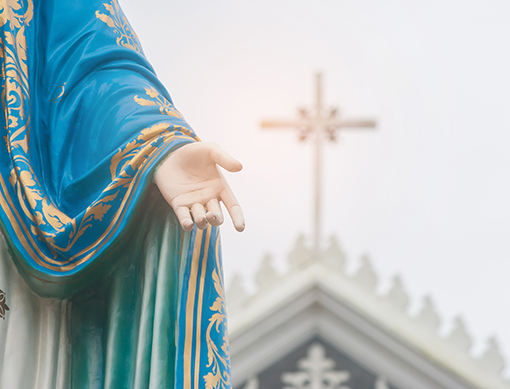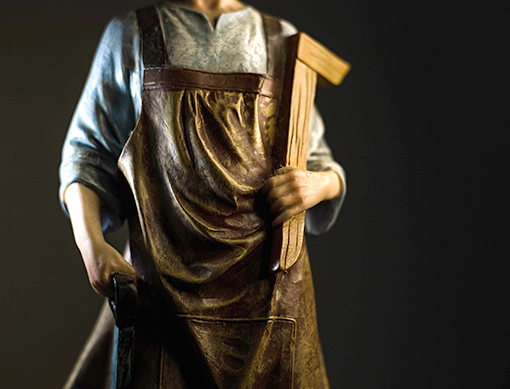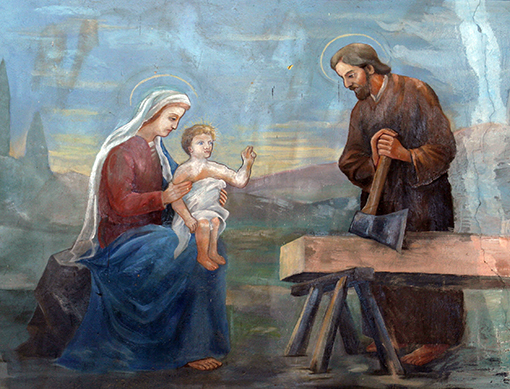What was your first job? What lessons did you learn from doing it? I remember my first job was in the billing office of my uncles’ lumberyard. I learned that words, not numbers, are my strength! I became a religion teacher.
 We know that any work has multiple benefits. Catholic teaching says work is more than a way to make a living; it is a form of continuing participation in God's creation, described in Genesis 2:4-5. The Catechism tells us, “Work is part of the original state of man and precedes his fall; it is therefore not a punishment or curse.” (Compendium, p. 256). Work is a participation in the creation of God. Faith formation lessons can shape our students’ attitudes about the work they will do when they enter the working world.
We know that any work has multiple benefits. Catholic teaching says work is more than a way to make a living; it is a form of continuing participation in God's creation, described in Genesis 2:4-5. The Catechism tells us, “Work is part of the original state of man and precedes his fall; it is therefore not a punishment or curse.” (Compendium, p. 256). Work is a participation in the creation of God. Faith formation lessons can shape our students’ attitudes about the work they will do when they enter the working world.
On May 1, the Church celebrates the feast of St. Joseph the Worker, who was a carpenter by trade. Celebrating the work that Joseph did to support his family helps us to remember to pray that God watches over all workers and protects them from accidents. We honor St. Joseph the Worker when we respect and appreciate all workers.
Pope Francis has said the fact that St. Joseph, as well as Jesus, practiced carpentry reminded him "of all the workers in the world, especially those who do grueling work in mines and factories" as well as "those who are exploited through undocumented work." Workers have the right to fair wages and safe working conditions. "Earning bread is what gives you dignity and if we do not give our people, our men and women, the ability to earn bread, this is a social injustice in that place, in that nation, in that continent," he said.
Essential Tools. Ask students to identify some kinds of work they see people doing in their community. They may list teachers, landscapers, bus drivers, police officers, builders, store clerks. Ask them to mention work that their own family members do. After you have a list, ask what kinds of tools each worker needs to do their work well. Finally, remind students that all workers also need God’s grace and protection for their work. Reflect together on the beginning of Psalm 127:
Unless the LORD build the house, they labor in vain who build.
Unless the LORD guard the city, in vain does the guard keep watch.
It is vain for you to rise early and put off your rest at night,
To eat bread earned by hard toil—all this God gives to his beloved in sleep.
Praying for Workers. “St. Joseph, you showed us the dignity of working to support your family. Protect all workers in their daily tasks and defend them from becoming discouraged. Inspire all who are responsible for workers, employers and government leaders, to guard the safety and rights of all who work. Help unemployed people to find satisfying work. May we learn how to best use your talents for the good of all. Amen.”
 About the Author
About the AuthorDr. Lauri Przybysz specializes in equipping families to live their vocation to be domestic churches and signs of God’s love. Lauri received the Doctor of Ministry from the Catholic University of America, and she has been both a Catholic middle school religion teacher and a faith formation coordinator at the archdiocesan and parish levels. She is the mother of six children and grandmother of 21.
One morning, while I was sitting in the parking lot of a lovely church at the Jersey shore, I noticed a lovely statue of Mary in the garden directly in front of my car. I had never seen anything like it before. There was something about her face that drew me. Upon closer examination I saw that the statue was titled, “Our Lady of the Smile.”
 Immediately, I smiled. I wondered how many others had that same reaction, and I marveled that I had never heard of this title of Mary before. I wondered where this title originated and imagined there must be many other titles of which I was unaware.
Immediately, I smiled. I wondered how many others had that same reaction, and I marveled that I had never heard of this title of Mary before. I wondered where this title originated and imagined there must be many other titles of which I was unaware.
A little research led me to the story of St. Therese of the Child Jesus who was critically ill as a young child and, doctors feared, close to death. A family statue of Mary as Our Lady of Victory was in the room and Therese’s sisters knelt to pray for her recovery.
In her autobiography, “Story of a Soul,” St. Therese, the Little Flower, writes, “All of a sudden the Blessed Virgin appeared beautiful to me, so beautiful that never had I seen anything so attractive; her face was suffused with an ineffable benevolence and tenderness, but what penetrated to the very depths of my soul was the ‘ravishing smile of the Blessed Virgin.’ At that instant, all my pain disappeared, and two large tears glistened on my eyelashes, and flowed down my cheeks silently, but they were tears of unmixed joy. Ah! I thought, the Blessed Virgin smiled at me, how happy I am…”
As the story was shared, devotion to Our Lady of the Smile grew.
The Marian month of May is a wonderful time to help children to get to know Mary, who is beloved and honored all over the world. They may have wondered, like me, why she is called by so many titles and what they mean.
While some of her titles are officially accepted by the Church, others are the result of pious tradition. All are meaningful.
The All About Mary website at Dayton University explains that among the reasons for her varied titles are:
She is a person. And as a person, descriptions of her are unlimited. “As individuals we are ineffable, meaning nobody – except God – has the last world on who we are and may become.” Certainly, that is true of Mary, of all people! And I love that description of an individual, something so important for children to know – they are not limited in who they may become. Many of Mary’s titles reflect her character and her roles – Mother of God, Queen of Peace, Star of the Sea, Queen of the Angels, Seat of Wisdom.
She is our intercessor. Since ancient times, the faithful have gone to Mary with all their needs, and, as human beings, our needs are many. Many of her titles reflect her role in giving us aid and maternal care, such as Our Lady of Comfort; Mary, Help of Christians; Mother of the Poor, Untier of Knots, and Mother of Mercy.
She belongs to all places and cultures. Mary is so loved in all parts of the world and by people of every race and culture, that it’s no surprise she bears titles that identify her as part of those places and people.
also carries the titles of some of places where she appeared, or some of the characteristics show in the apparition, such as Our Lady of the Smile; Our Lady of Knock, Ireland; Our Lady of Candles, Philippines, and Our Lady of Guadalupe, Mexico.
Teachers: Check out RCL Benziger’s online Catholic resources for Marian Devotion, and Mary, Our Mother resource pages, which include various grade level activities for lessons on Mary, as Our Lady of the Abandoned Ones; Our Lady of Abundance; Our Lady of the Candles; Our Lady of Good News; Our Lady of the Grasshopper, and Our Lady of the Smile.
 About the Author
About the AuthorMary Clifford Morrell, mother of six and grandmother to ten, is a Catholic journalist, editor, and author who has served the Dioceses of Metuchen and Trenton, New Jersey; Burlington, Vermont, and RENEW International in the areas of religious education and communication.
There are times, whether we are teachers, writers, engineers, counselors or chefs, when we have to move past our skills, experience and wisdom, and pick up a broom.
 Sometimes, the repetitive sweep, sweep, sweep, was a satisfying meditation that cleaned away the dust and crumbs and left things refreshingly clean.
Sometimes, the repetitive sweep, sweep, sweep, was a satisfying meditation that cleaned away the dust and crumbs and left things refreshingly clean.
Other times, we pick up the broom with a grumbling heart, tired of the mundane, boring task of sweeping – again.
It was in one of those grumbling moments when a conversation with a favorite monsignor came to mind. He shared with me his deep appreciation for Our Lady of the Broom. As I heard, again. the joy and laughter in his voice as he spoke about the Mother of God, Queen of Heaven, pushing a broom around the floor of her modest home in Nazareth, I began to smile, as well.
He reminded me that we tend to take ourselves too seriously, think of ourselves too highly, when the everyday blessing of caring for the gift of a home – or a classroom, or an office or a kitchen – is reason to complain. Sweeping, he reminded me, is an exercise in humility, as Mary has modeled for us.
With the rise of social media, the glorification of vanity, and the need for youth to compete for attention, especially difficult when they are not the kind of person who really wants to seek the spotlight, lessons in the meaning and value of humility is a positive thing.
How can we encourage children and youth to embody Mary’s humility?
Paint a visual picture – Children know Mary most often by the images they see in their textbooks or hanging on the wall in their homes or parishes, and while there are some statues and images of Our Lady of the Broom, it’s unusual to see them. Painting a visual picture of a day in the life of Mary will help them appreciate Mary’s role caring for her family, a role that was a highly respected one for Jewish women in Old Testament times (Read Proverbs 31:10-31), but which changed dramatically during New Testament times. That is why Jesus’ talking to women, especially one on one, was such a radical behavior.
Highlight the strengths of others – Helping others recognize and develop their own strengths is a trait of humble people. Encourage them to light the flame of others instead of being flame snuffers by bragging about their own strengths and talents. Ask students to identify their own gifts and talents and ask them how they might share them to help others develop their own strengths. One day a week, pick up a broom, and let children help put the classroom back in order. Cooperation and personal responsibility are definite strengths for youth.
Humility is service – When we learn about Mary, beginning with her “yes” to God, we understand true humility includes service. Mary does not think of herself as less or more than anyone else, she just acknowledges who she is, “the handmaid of God.” We see her desire for service when she travels to take care of the needs of her pregnant cousin Elizabeth. We see it again when she asks Jesus to turn water into wine for the couple in Cana, and, most important, in her presence throughout Jesus’ ministry and at the foot of the Cross. Ask children for suggestions on how they can be of service to others, in the classroom and at home.
Teaching humility requires modeling – Being humble means being teachable. Be open to listening and learning about your students and your faith. Be curious and attentive to learning new things and set the example for students. Acknowledge your faults and failures as opportunities to do better, and express gratitude to God for your gifts, talents and successes. While it’s important to applaud students’ efforts, encourage them to also praise God for the gift of who they are.
For teachers: In this beautiful reflection, The Gift of Humility - Grateful.org, author Colette Lafia writes, “Humility and gratitude are about acknowledging a togetherness we all live in – with each other, with nature, and with the Sacred. We are invited to take our place with grace, in great and growing gratitude,” and offers us a lovely gratitude practice.
 About the Author
About the AuthorMary Clifford Morrell, mother of six and grandmother to ten, is a Catholic journalist, editor, and author who has served the Dioceses of Metuchen and Trenton, New Jersey; Burlington, Vermont, and RENEW International in the areas of religious education and communication.
Lent is our greatest season of hope because it awaits the great mystery of Jesus resurrection on Easter morning. Hope means “to want and expect.” Christians hope in Christ and that hope will not disappoint us (Romans 5:5). It is a feeling that what is wanted will happen. We pray during Lent and throughout the year, that God will empower us to be positive and help us also seek and see the goodness in one another. We can help our students to look at the world with hopeful eyes. When we have hope, our outlook on the world will be more optimistic.
 One of the most important habits of mind that children can develop is optimism. Pessimism, on the other hand, leads to helplessness and withdrawal – it doesn’t matter what I do, it won’t work, so there is no point in trying. Optimism is not about temperament; it is a habit of thinking that relates to how we interpret events. And it can therefore be taught.
One of the most important habits of mind that children can develop is optimism. Pessimism, on the other hand, leads to helplessness and withdrawal – it doesn’t matter what I do, it won’t work, so there is no point in trying. Optimism is not about temperament; it is a habit of thinking that relates to how we interpret events. And it can therefore be taught.
Optimism has been found to be one of the key characteristics of resilient people. The brain can be rewired to be more optimistic through the experiences it is exposed to. This doesn’t mean invalidating one’s pessimistic feelings. Acknowledge their view of the world, and introduce them to a different one. Children who practice optimistic thinking are more resilient, they are less likely to give up in the face of challenge, and they tend to interpret experiences in a way that gives them a sense of control and confidence.
Prayer Treasure Chest. Materials: shoe box or other box with a lid, old magazines, scissors, glue, stickers, colorful paper. Students cut out pictures that remind them of hope and love, and glue them on the box. Have students write (or help little ones write) three prayers on separate slips of paper and place the prayers in the Treasure Chest. Before faith formation class begins, ask each person to draw out a prayer to read privately to themselves. Close the silent prayer time with a prayer for the group to hope in Christ. Make time for everyone to add more prayers and intentions in the coming weeks.
Rice Bowl of Hope. Materials: bowl, paper, and pen. Or use an Operation Rice Bowl box from Catholic Relief Services. One way of sharing hope with others is by giving alms. Plan to conserve one meal a week and use the money for the Rice Bowl. At the end of Lent, give the money to your local poor or to Catholic Relief Services.
Popcorn Reflection. Make some popcorn, and discuss how the kernels change and become transformed. (The good food was hidden within the hard shell.) Share ideas on how we can be compared to popcorn in our own lives. Can you think of another food metaphor for hidden blessings?
Sharing Our Optimism Stories. Invite students to work with a partner or a small group.
• Each share a story about a hope he or she had and how things worked out.
• Share a funny story about him or herself.
• Share a time you felt especially cared for by someone.
 About the Author
About the AuthorDr. Lauri Przybysz specializes in equipping families to live their vocation to be domestic churches and signs of God’s love. Lauri received the Doctor of Ministry from the Catholic University of America, and she has been both a Catholic middle school religion teacher and a faith formation coordinator at the archdiocesan and parish levels. She is the mother of six children and grandmother of 21.
In this culture of social media, messaging is something to which youth can easily relate.
 For them, messages may be sent and returned in an instant, without any personal interaction at all. But Scripture teaches us that in the time of the Hebrew people, messages often came with the aid of an angel.
For them, messages may be sent and returned in an instant, without any personal interaction at all. But Scripture teaches us that in the time of the Hebrew people, messages often came with the aid of an angel.
Those were the messages you didn’t want to miss because they were messages from God.
Among those very important messages was the most important one for humanity, in which the Angel Gabriel came to a young Jewish woman to tell her God had chosen her to be the mother of the savior of the world – Jesus, the Son of God.
We can only imagine how this message, and this opportunity, confused all of Mary’s plans for what her life would be like,” and yet she listened to Gabriel’s words, “Be not afraid,” and offered her freely chosen “yes” to God.
This marked the moment Jesus was conceived through the power of the Holy Spirit. This life-changing message for Mary and whole of humanity, and Mary’s response, is celebrated as the Solemnity of the Feast of the Annunciation of the Lord on March 25.
And, though in the middle of Lent, the Annunciation is a feast of joy. The liturgical color is white instead of the Lenten purple, and, unlike during Lent, the Gloria is sung at Mass. Also, a solemnity is the highest-ranking feast in the liturgical calendar, certainly appropriate for the event which brought God into the world as one of us.
And there, at the heart of the story, is the Archangel Gabriel, sent as God’s messenger.
We see this often in Scripture, God using his angels as messengers, to enlighten, protect and lead people to God. In a 2018 homily, Pope Francis recalled God’s words to Moses from the Book of Exodus: “Behold, I send an angel before you, to guard you on the way and to bring you to the place which I have prepared.”
In a 2018 homily on the Feast of the Guardian Angels, Pope Francis spoke about life as a journey and shared some interesting thoughts about angels, and their importance in our lives:
• “There is the danger of not going on the journey. And how many people settle down, and don’t set out on the journey, and their whole life is stalled, without moving, without doing anything…The angels help us, they push us to continue on the journey.”
• “I want to ask you a question: Do you speak with your angel? … Do you listen to your angel? Do you allow yourself to be led by hand along the path, or do you need to be pushed to move?”
• “Our angel is not only with us; he also sees God the Father. He is in relationship with Him. He is the daily bridge; from the moment we arise to the moment we go to bed. He accompanies us and is a link between us and God the Father. … Let us not forget these companions on the journey …”
Spend some time reflecting on the words of Pope Francis and consider your own relationship with the angels, especially your own guardian angel. Then reflect on how you can help your students learn more about the angels. Consider the following:
Pray the Guardian Angel Prayer with your students as often as you can. Repetition will enable students to memorize the short prayer and pray it when they feel the need of courage or comfort – Angel of God, my guardian dear, to whom God’s love commits me here; Ever this day be at my side, to light and guard, to rule and guide. Amen
Encourage children to listen to their angels, especially when making difficult decisions – This is a process of discernment, prayer and time to ask for and listen for guidance. It prevents hasty decisions that often lead to very big mistakes.
Encourage your students to create an artistic rendering of their guardian angel – We don’t know what angels look like, but giving children the opportunity to imagine their angel will help them give form and shape and personality to a protector given to them by God.
Take to heart the words of St. Pope John Paul II – "Teach the children that they are never alone, that an angel is at their side. Show them how to have a trusting conversation with the angel, who is a good advisor and intercedes for you and helps you in your needs." – St. Pope John Paul II
 About the Author
About the AuthorMary Clifford Morrell, mother of six and grandmother to ten, is a Catholic journalist, editor, and author who has served the Dioceses of Metuchen and Trenton, New Jersey; Burlington, Vermont, and RENEW International in the areas of religious education and communication.
There’s a lot to be said about imagining. It’s a regular pastime of children, and a wonderful tool for teaching. It’s also at the heart of all creative endeavors. Can you imagine a world where there is no imagination?
 Since March is also the month dedicated to St. Joseph, it presents a wonderful opportunity to do some imagining about the earthly father of Jesus, so important in the life of the Son of God, but from whom there is not a word inscribed in Scripture.
Since March is also the month dedicated to St. Joseph, it presents a wonderful opportunity to do some imagining about the earthly father of Jesus, so important in the life of the Son of God, but from whom there is not a word inscribed in Scripture.
St. Joseph is mentioned in the Nativity stories in the Gospels of Matthew and Luke, once in the Gospel of John when someone refers to Jesus as the “son of Joseph,” and no where else in Scripture, even in the Gospel Mark.
What we do know about St. Joseph from Scripture is very limited, and what we’ve heard about St. Joseph, like his age or when or how he died, comes from oral and written tradition, often from ancient documents that were not part of the books of Scripture.
So, what do we actually know from Scripture?
Joseph was a carpenter, or, in the original Greek of the Scriptures, a “tekton,” a person skilled in using materials of all kinds. Jesus was known as the carpenter’s son. Neighbors were probably familiar with father and son working together, not only in their shop, but making repairs or doing first century remodeling on local homes or businesses.
Joseph was the spouse of Mary and foster father of Jesus. His family depended on him. He passed on values, traditions, and his Jewish faith. They went on pilgrimage together to the Temple in Jerusalem where they lost Jesus for a few days. As any good father would, he went back to look for him with Mary. No doubt there were other times when Joseph had to intervene in some adventure of Jesus, as a child or as a teenager.
Joseph listened and was obedient to God. Joseph is sometimes referred to as the man of dreams because it was through angels speaking to him in dreams that God communicated his plans to Joseph. Three of those times included when an angel of the Lord tells him to take Mary as his wife and name the child Jesus; to flee by night into Egypt with Mary and Jesus, to return to Israel with his family, and to move to Galilee where he establishes his home in Nazareth.
A Day in the Life of St. Joseph: An exercise in imagining
Using both your curriculum guides and Bibles, help your students come to know Joseph a little bit better, at least as more than a statue with a staff standing in the Nativity scene. Then encourage them to write or draw a day in the life of St. Joseph as they imagine it might have been. They might need help with a little imagery of the environment the Holy Family lived in. Some of it might be in student texts, but some library research would held engage the students in creating their literary or artistic masterpiece.
For teachers: Check out Pope Francis’ 2021 Catechesis 1 on St. Joseph – St. Joseph and the environment in which he lived. It includes what he calls a “home-made prayer” to St. Joseph, that comes from the heart:
Saint Joseph,
you who have always trusted God,
and have made your choices
guided by his providence
teach us not to count so much on our own plans
but on his plan of love.
You who come from the peripheries
help us to convert our gaze
and to prefer what the world discards and marginalises.
Comfort those who feel alone
and support those who work silently
to defend life and human dignity.
Amen.
 About the Author
About the AuthorMary Clifford Morrell, mother of six and grandmother to ten, is a Catholic journalist, editor, and author who has served the Dioceses of Metuchen and Trenton, New Jersey; Burlington, Vermont, and RENEW International in the areas of religious education and communication.
Lent comes around every year, and it is a good thing! We are all called to continually be renewing our faith and growing in our relationship with Jesus Christ and with one another. We are called to be better Christians today than we were yesterday, and better tomorrow than we are today. This call to ongoing conversion can be described in the word, Metanoia. Metanoia is a Greek word the Gospels use for that two-fold process of turning from sin and toward God.
 Along with us adults, children first need to hear again and again the proclamation of the Good News, “the mighty works of God” (Evangelization in the Modern World, Pope Paul VI, 15). If our faith is alive, it will be aroused again and again as we mature as disciples.
Along with us adults, children first need to hear again and again the proclamation of the Good News, “the mighty works of God” (Evangelization in the Modern World, Pope Paul VI, 15). If our faith is alive, it will be aroused again and again as we mature as disciples.
What experiences can arouse the faith of children? Our faith formation classes in school and in the parish are a vital source of those faith experiences. We aim to make the most of the time we spend with our students and their families. Having programs and resources like Be My Disciples and Blest Are We Faith in Action, gives us the tools to be systematic about providing the content for formation that is ongoing. Download a worksheet on Repenting for Lent that works for multiple age groups.
Having Mercy on Ourselves. Growth and change can be hard. Along with teaching children about repentance and renewal, we need to teach them to be patient with themselves when they sometimes fail to be kind and loving. God is gentle with people, and we need to be gentle with ourselves. Teach children that God loves their efforts to do better each day.
Nurture Hope for Human Nature. We can change, and so can other people. Research has found that children who have a belief that people have the potential to change are more likely to show resilience when things get tough. Compared to kids who believe that bullies will always be bullies and victims will always be victims, kids who believe that people can change report less stress and anxiety, better feelings about themselves in response to social exclusion, and better physical health.
Testimonies to Growth. Stories from the Bible, like the parable of the Prodigal Son (Luke 15:11-32), teach children that God is always eager and waiting to receive back one who wants to change. Not every saint started out saintly, either. Some people whom we revere today changed their lives to follow Jesus: St. Ignatius of Loyola, St. Augustine of Hippo, Servant of God Dorothy Day.
Dramatize Metanoia. In the story of the Prodigal Son in Luke 15:11-32) the son rashly wastes his inheritance, but the loving father, like God, welcomes him back when he repents and changes his life (metanoia). Read the parable as a class. A short video of the story is available with the Blest Are We Faith in Action, Grade 4, Unit 4 in Flourish (you will need to be logged into your account to see this). Ask for volunteers to portray each of the characters in their own words. Ask the rest of the class for their reactions and lessons they take away from seeing the story in action.
 About the Author
About the AuthorDr. Lauri Przybysz specializes in equipping families to live their vocation to be domestic churches and signs of God’s love. Lauri received the Doctor of Ministry from the Catholic University of America, and she has been both a Catholic middle school religion teacher and a faith formation coordinator at the archdiocesan and parish levels. She is the mother of six children and grandmother of 21.
Sunday afternoon at grandma’s house helping a three-year-old get dressed for 30-degree snowy weather:
“You need to put your jacket on.”
“Why?”
“It’s very cold outside.”
“Why?”
“Well, it’s winter.”
“Why?”
 The “whys” are rapid fire, as if he’s expecting the volley of questions and answers. But explaining seasons and weather to a young child takes some thought. I hesitate, realizing that no matter what I say it will be followed with his adorable and frustrating query.
The “whys” are rapid fire, as if he’s expecting the volley of questions and answers. But explaining seasons and weather to a young child takes some thought. I hesitate, realizing that no matter what I say it will be followed with his adorable and frustrating query.
In a weak moment, I reply, “Look, if you don’t put your jacket on you will look just like that little snowman on the front lawn.” Now he hesitated and finally stuck an arm in one sleeve. As he slid the second arm in, he turned around with scrunched eyebrows and said, “How?”
I can never win.
Anyone who works with children knows their penchant for questions, and one of their favorites is “Why?”
It begins early and by the age of three, it’s often the most expressed question in response to just about anything you say to them. It’s also a crucial component of brain development and expansion of knowledge that helps them make sense of their world.
They also develop a sense of who they should go to for questions to be answered, who answers them best, and willingly. But educators and child psychologists recognize that once children are introduced to a school setting, their questioning often diminishes, sometimes because they are discovering the answers themselves but also because their questions are discouraged.
Answering “why” questions about religion can be challenging, because religion can be complex and the answers, especially for younger students, are sometimes difficult to understand. Finding ways to make our Catholic faith easier to understand goes a long way in helping students live their faith.
Lent is a wonderful opportunity to encourage questions, and with older students, support their efforts to discover and express their own answers, about any number of Lenten practices:
• Why do Catholics celebrate Lent?
• Why is there a season of Lent (rather than just a feast day)?
• Why do we begin Lent with ashes?
• Why is the season of Lent 40 days?
• Why are prayer, fasting and almsgiving the pillars of Lent?
• Why do we need to prepare for Easter?
If your students haven’t already asked you, ask them some “why” questions about Lent. Or have them write their own questions down. Invite the parish priest, religious sister or brother, or deacon to visit and answer some, or all of the questions.
Some thoughts from Pope Francis’ Easter message are also inspirational, especially for teachers. He speaks of the experience of the Apostles who are present for the Transfiguration of Jesus on Mount Tabor, and reminds us, “During any strenuous mountain trek, we must keep our eyes firmly fixed on the path; yet the panorama that opens up at the end amazes us and rewards us by its grandeur.”
This is an image children can understand, and would do a great job or creating into Lenten art.
The Holy Father also underscored the words of God to the disciples, His voice coming through the clouds: “Listen to him.”
Pope Francis stressed “… we need to listen to Jesus. Lent is a time of grace to the extent that we listen to him as he speaks to us.” This is a lesson that even the youngest student can understand if they have been taught the lessons of Jesus.
In addition to the liturgical year section in RCL Benziger religion textbooks, which include such lessons as Ash Wednesday, Lent, Palm Sunday, and Holy Week, a free series of downloadable Lenten and Triduum resources are also offered here. The United States Conference of Catholic Bishops also offers online resources to help answer some of the “why” questions of Lent.
What is Lent? | USCCB
Why is Lent 40 Days? | USCCB
Why Ashes? | USCCB
 About the Author
About the AuthorMary Clifford Morrell, mother of six and grandmother to ten, is a Catholic journalist, editor, and author who has served the Dioceses of Metuchen and Trenton, New Jersey; Burlington, Vermont, and RENEW International in the areas of religious education and communication.
As we travel through our neighborhoods, it’s likely we will be reminded of the holiday or season of the month, according to which flags are flying on the homes we pass, or in many cases, the lights and decorations which adorn their properties – St. Patrick’s Day, Fourth of July, Halloween, Valentine’s Day, Thanksgiving, and, of course, Christmas.
 What may not be well known, even for Catholics, is that each month of the year is also a time for the faithful to celebrate and honor something special in the Church. Every month has an intention.
What may not be well known, even for Catholics, is that each month of the year is also a time for the faithful to celebrate and honor something special in the Church. Every month has an intention.
For the month of February, Catholics honor the Holy Family, a frequent teaching of Pope Francis: “Today our gaze on the Holy Family lets us also be drawn into the simplicity of the life they led in Nazareth. It is an example that does our families great good, helping them increasingly to become communities of love and reconciliation, in which tenderness, mutual help, and mutual forgiveness is experienced.
“Let us remember the three key words for living in peace and joy in the family: “may I,” “thank you” and “sorry” … I would also like to encourage families to become aware of the importance they have in the Church and in society. The proclamation of the Gospel, in fact, first passes through the family to reach the various spheres of daily life.”
Children are familiar with experiences of love and forgiveness, caring and helpfulness within their own families. They are also familiar with anxiety, anger, disappointment and fear. What they know about the Holy Family may not be enough for them to think of Mary, Joseph and Jesus in terms of a real family, like theirs, who experience the ups and downs of family life.
The fact that the month of the Holy Family comes so soon after Christmas means teachers can make use of the image of the Nativity which is fresh in the mind of students. If they haven’t seen one at home, they have likely seen one in the classroom. This may be the only scene they’ve ever envisioned of the Holy Family, but that holy night was just the beginning of their family life together.
Let students imagine the day-to-day life of the Holy Family, from Jesus’ birth in Bethlehem until his death and Resurrection. Encourage students to imagine the life of the Holy Family as they live their own lives as a family, and to tell, write, or draw their ideas of how the Holy Family might have set up a home in Nazareth, the kind of chores Jesus had to do, how he helped Joseph in the family carpentry business, how he studied and learned his faith. What was Jesus like, as a young person like them? Did Jesus get in trouble if he threw his prayer shawl on floor instead of hanging it up or was late to dinner?
Include visual displays, especially in the prayer corner. An image, including prayer cards, or a statue of the Holy Family, serves as a daily reminder for students that the month is dedicated to the Holy Family. If there is a box or jar for prayer intentions, direct students to address their intentions during the month to the Holy Family. Encourage them to write prayer intentions for family members.
Read Scripture, especially Luke 2:41-52, the story about Jesus remaining behind in Jerusalem after the family travels there to go to the temple. It’s a great opportunity to discuss how every family, even the Holy Family, experience difficult situations, and to discuss how the Holy Family handled this one.
Pray. As observant Jews, Mary, Joseph and Jesus would have followed Jewish law and offered formal prayers in their home several times a day, in addition to praying always in their hearts. One of the daily prayers, said morning and evening, would have been the Shema in the Book of Deuteronomy. Chapter 6, verses 4-9 (printed below) are good for students to read, too, to gain a better understanding of what was important to the Holy Family. The first line is a profession of faith: “Hear O’ Israel, the Lord is our God, the Lord is One.”
In addition, you might add a prayer specifically for the family and pray it as a class at least once a week during the month, perhaps on Friday before the students go home for the weekend, or more often if time allows. The prayer below, from the Missionaries of the Holy Family, may be used.
For teachers – For those interested in including Catholic themes of the month into their religion classes, or their classrooms, here’s the list for the rest of the year: March, St. Joseph; April, Holy Eucharist and Holy Spirit; May, Virgin Mary; June, Sacred Heart of Jesus; July, Precious Blood of Jesus; August, Immaculate Heart of Mary; September, Seven Sorrows of Mary and the Holy Cross; October, Rosary; November, Poor Souls in Purgatory; December, Advent or the Coming of Christ.
The Holy Family Prayer
Jesus, Son of God and Son of Mary, bless our family. Graciously inspire in us the unity, peace, and mutual love that you found in your own family in the little town of Nazareth. Mary, Mother of Jesus and Our Mother, nourish our family with your faith and your love. Keep us close to your Son, Jesus, in all our sorrows and joys. Joseph, Foster-father to Jesus, guardian and spouse of Mary, keep our family safe from harm. Help us in all times of discouragement or anxiety. Holy Family of Nazareth, make our family one with you. Help us to be instruments of peace. Grant that love, strengthened by grace, may prove mightier than all the weaknesses and trials through which our families sometimes pass. May we always have God at the center of our hearts and homes until we are all one family, happy and at peace in our true home with you. Amen. From the Missionaries of the Holy Family
The Shema
Hear, O Israel: The Lord is our God; the Lord is one. And you shall love the Lord, your God, with all your heart and with all your soul, and with all your means. And these words, which I command you this day, shall be upon your heart. And you shall teach them to your sons and speak of them when you sit in your house, and when you walk on the way, and when you lie down and when you rise up. And you shall bind them for a sign upon your hand, and they shall be for ornaments between your eyes. And you shall inscribe them upon the doorposts of your house and upon your gates (Deut. 6:4-9).
 About the Author
About the AuthorMary Clifford Morrell, mother of six and grandmother to ten, is a Catholic journalist, editor, and author who has served the Dioceses of Metuchen and Trenton, New Jersey; Burlington, Vermont, and RENEW International in the areas of religious education and communication.
Ash Wednesday begins a wonderful season of reflection and preparation. Receiving the ashes as a member of the church community helps children recognize that they are an important part of the Catholic community and are united with the Church in its Lenten preparation. It is believed that Ash Wednesday was first observed in the Middle Ages around the 8th century. It was first called the Day of Ashes. Since then, the practice has also become an annual ritual in many other Christian churches, including Lutherans and Methodists.
 Ash Wednesday provides an incredible teaching moment for kids. This is an opportunity to intentionally pass on the truth that life is but a breath and that our eternal relationship with God is our primary goal. The sage teaches us, "It is better to go to a funeral than to go to a party, because death is the destiny of everyone. The living should take this to heart" (Ecclesiastes 7:2).
Ash Wednesday provides an incredible teaching moment for kids. This is an opportunity to intentionally pass on the truth that life is but a breath and that our eternal relationship with God is our primary goal. The sage teaches us, "It is better to go to a funeral than to go to a party, because death is the destiny of everyone. The living should take this to heart" (Ecclesiastes 7:2).
On Ash Wednesday, we receive a sign of the cross on our foreheads from ashes (usually made from the palms used on Palm Sunday the previous year). This mark is a reminder of our mortality--we are all going to die--and a call for repentance. The person who gives the signs says over you, "Remember you are dust, and to dust you will return" (Genesis 3:19b) or “Turn away from sin and be faithful to the gospel” (adapted from Mark 1:15).
Lent is a time of prayer, penance and sacrifice, a time for the entire family to be more attentive to the words of Jesus and to each other. It is a time to try harder to put Christ’s teachings into practice. The Church asks everyone 14 years of age or older is bound to abstain from meat on Ash Wednesday, all the Fridays of Lent and Good Friday. Everyone 18 or older, and under 59 years of age, is bound to fast on Ash Wednesday and Good Friday.
While children are not bound to observe these penitential practices, they will benefit from participating.
On a Positive Note. Lent means doing something as well as giving up something. They could choose a positive action for each day of Lent.
A New Take on Fasting. Ask students to brainstorm creative ways they could fast during Lent. Ask your class to add to these ideas:
- Fast from fast food.
- Fast from TV one day a week.
- Fast electronic games one day a week.
- Fast from using the computer and spend that time with your family.
- Fast from buying anything that is unnecessary during Lent.
- Fast from bad habits that need to be changed or given up.
Making the Most of Lent in the Classroom. To help your students go deeper into the Lent, your Blest Are We Faith in Action series provides “Feasts and Seasons” lessons near the end of the student book at all levels. The teaching resources provided include the Teacher or Catechist Background page, Resources, and At-A-Glance Planner. The lessons follow the same Share, Hear and Believe, and Respond process as the unit chapters. Also, look for free downloadable resources from RCL Benziger for Lent.
 About the Author
About the AuthorDr. Lauri Przybysz specializes in equipping families to live their vocation to be domestic churches and signs of God’s love. Lauri received the Doctor of Ministry from the Catholic University of America, and she has been both a Catholic middle school religion teacher and a faith formation coordinator at the archdiocesan and parish levels. She is the mother of six children and grandmother of 21.
Pagination
Latest
Categories
Archives
- February 2015 (2)
- March 2015 (2)
- April 2015 (5)
- May 2015 (3)
- June 2015 (6)
- July 2015 (3)
- August 2015 (5)
- September 2015 (5)
- October 2015 (4)
- November 2015 (2)
- December 2015 (1)
- February 2016 (2)
- March 2016 (1)
- April 2016 (2)
- May 2016 (2)
- July 2016 (2)
- August 2016 (2)
- September 2016 (1)
- October 2016 (5)
- November 2016 (1)
- December 2016 (3)
- January 2017 (2)
- February 2017 (3)
- March 2017 (2)
- April 2017 (1)
- June 2017 (2)
- July 2017 (2)
- August 2017 (1)
- April 2018 (1)
- October 2018 (2)
- December 2018 (2)
- February 2019 (3)
- March 2019 (2)
- April 2019 (2)
- May 2019 (3)
- June 2019 (1)
- July 2019 (16)
- August 2019 (8)
- March 2020 (4)
- April 2020 (6)
- May 2020 (8)
- June 2020 (7)
- July 2020 (5)
- August 2020 (7)
- September 2020 (4)
- October 2020 (5)
- November 2020 (9)
- December 2020 (11)
- January 2021 (10)
- February 2021 (8)
- March 2021 (5)
- April 2021 (4)
- May 2021 (4)
- June 2021 (5)
- July 2021 (2)
- August 2021 (3)
- September 2021 (4)
- October 2021 (4)
- November 2021 (2)
- December 2021 (5)
- January 2022 (4)
- February 2022 (4)
- March 2022 (9)
- April 2022 (7)
- May 2022 (9)
- June 2022 (12)
- July 2022 (7)
- August 2022 (10)
- September 2022 (9)
- October 2022 (11)
- November 2022 (8)
- December 2022 (7)
- January 2023 (2)
- February 2023 (10)
- March 2023 (9)
- April 2023 (10)
- May 2023 (8)
- June 2023 (4)
- July 2023 (3)
- August 2023 (2)
